Don’t throw away that old bread! See how these readers’ fresh ideas can breathe life into fusty foodstuffs.
Even the most organised cooks among us (of which, sadly, I am not one) can struggle to use up the odds and ends at times. But having let my bread go stale, my cake go dry and biscuits go soft in aid of this week’s theme, I can testify that these dishes can be some of the most satisfying you’ll ever make.
Much as it pained me to allow brioche to go stale, Camilla Hawkins’ chocolate spread brioche pudding recipe more than delivered – with rich oozy chocolate and a custardy set, I can see why this is a firm family favourite.
Half a loaf of sourdough bread was put to good use in Marmaduke Scarlet’s classic Spanish migas; the meat fat really brought the crumbs back to life, giving a fry-up much more interest and texture. The other half went to Angela Kim’s winter panzanella. The roasted garlic dressing was a revelation, and the combination of root veg, iron-rich kale and crunchy croutons made for a hearty but elegant salad.
Every dish I cooked was delicious, but the cake from LeftoverLiz quite literally took the biscuit. Who’d have thought that a pint of milk, a couple of eggs, a leftover apple and a few old biscuits could make such a show-off pudding? I’ve since tried it with digestives too, so don’t be afraid to experiment with the broken bits at the bottom of the barrel.
The winning recipe: Breton biscuit cake
Although I’ve made this pudding-cake with Breton galette biscuits (because I love their toffee buttery taste), the recipe will work well with any simple biscuits (malted milk, Nice and so on).
LeftoverLiz, via GuardianWitness
Serves 8-10
1 dessert apple or pear, peeled cored and chopped
1 tbsp butter, for greasing the tin
2 eggs
100g caster or vanilla sugar
500ml milk
1 tsp vanilla extract
150g stale biscuits
1 First make a compote with the apple or pear. Put the fruit in a small saucepan with a little water then stew it down to a pulp for around 15 minutes. Set aside to cool.
2 Generously butter a 15cm cake tin, then beat the eggs and sugar together in a bowl until the mixture goes pale in colour. Mix in the milk and vanilla.
3 Spread out the biscuits in a layer on the bottom of the tin, add a spreading of the fruit compote and then pour over some of the milk mixture.
4 Repeat with a second and even third layer until you have used up all your ingredients.
5 Leave it to soak while you preheat your oven to 180C/350F/gas mark 4 and then bake the cake for around 20-25 minutes until the custard is set. Leave to cool, sprinkle with icing sugar and serve in slices with cream.
Spanish migas
I often tell people that I have the appetite of a sparrow. How, people ask me incredulously as they admire my well-upholstered figure, do you maintain your exquisite physique? Crumbs, I say modestly. This delicious Spanish dish, migas, is the perfect way of using up leftover stale bread and is very good as a hearty breakfast.
Marmaduke Scarlet, via GuardianWitness

Serves 4 (as a side dish)
½ loaf of stale rustic-style bread, crusts removed and diced
2 rashers of thick-cut bacon
75g semi-dried chorizo, skinned and roughly chopped
3 tbsp olive oil
1 onion, finely chopped
2 garlic cloves (1 whole, 1 finely sliced)
¼ tsp ground cumin
½ tsp smoked paprika
Salt and black pepper
1 egg, fried in olive oil, to serve
Parsley, chopped, to serve
1 Tip the bread into a bowl, then dampen it with a sprinkling of water. Shake the bowl to distribute the water and bread. Repeat once. Cover. Set aside for 2 hours.
2 Remove the fat from the bacon, then put it in a cold frying pan over a medium heat and render it down until the fat is melted. Drain and reserve. Chop the rest of the bacon and add it to a pan over a gentle heat. Cook through, remove from the pan and set aside.
3 Add the chorizo to the pan, then gently fry to cook through. Remove and combine with the cooked bacon. Add any cooking fat to the bacon fat.
4 Heat 2 tbsp of the olive oil in the frying pan. Gently fry the whole garlic clove to flavour the oil. Remove garlic once golden brown. (Dispose of it or eat it – cook’s treat!) Return the flavoured fat to the pan with the oil, then gently fry the spices with a little salt and pepper. Add the bread and stir to ensure it’s well-coated with the oil. Cook over a very low heat, stirring occasionally, for about 30 minutes.
5 In another frying pan, heat 1 tbsp of olive oil. Add finely chopped onion, then fry for 10 minutes until softened. Add the chopped garlic, stir to combine, then gently cook for 5 minutes. Add the bacon and chorizo, then cook for another minute. Add this mixture to the fried bread and stir well to combine. Serve with a fried egg and chopped parsley.
Chocolate spread brioche pudding
The ultimate comfort pudding, which came about after buying some reduced brioche loaves. The staler the brioche the better, as it makes it more absorbent for the custard base. This is now the family’s favourite pudding.
Camilla Hawkinsvia GuardianWitness

Serves 6-8
Chocolate hazelnut spread
8–9 slices of stale brioche
3 large eggs
375ml semi-skimmed milk
1 tsp vanilla extract or paste
50g caster sugar
1 Preheat the oven to 180C/350F/gas mark 4. Spread a generous layer of chocolate spread on 4 slices of brioche and then sandwich together with the other 4 slices. (You may need the extra slice depending on the size of your bowl and thickness of bread). Cut the sandwiches diagonally into quarters.
2 In a large bowl whisk the eggs, add the milk, vanilla extract/paste and caster sugar and whisk again.
3 Dunk each quarter into the milk mixture and place pointed-side up into an ovenproof dish in rows. (If necessary, create an extra triangle with the spare piece of bread).
4 Pour the rest of the milk mixture over the brioche sandwiches and bake for 35 minutes, or until set.
Winter panzanella: a roasted root vegetables and bread salad
Who doesn’t love the classic summer salad, panzanella? Unfortunately, at this time of the year, the only local vegetables I find in Germany are root vegetables. It was frustrating at first but one becomes a champion at cooking them after years of living here. This is my winter version of panzanella. It’s healthy, substantial and thrifty. You can substitute with other winter root vegetables, such as black turnip, parsnip, celery root or golden beetroot. If kale isn’t available, an equal amount of thinly sliced red cabbage works just as well.
Angela Kim, via GuardianWitness
Serves 4
For the salad
About 200-300g stale sourdough bread, cut into 3cm cubes
Olive oil
4 medium carrots, cut into 2cm cubes
4 banana shallots, sliced into thick discs
½ medium swede, peeled and cut into 2cm cubes
1 small head of garlic, left whole, with its papery outer skin removed
Salt and black pepper, to taste
½ tbsp coriander seeds, lightly crushed
1.5 tsp cumin seeds, lightly crushed
1 tsp sweet paprika powder
1-2 sprigs of rosemary or thyme
6-8 leaves of kale, tough stems removed, and the leaves finely sliced
100g cooked, leftover green, brown, or beluga lentils, warmed (optional)
For the dressing
Roasted garlic flesh (from above)
1 tbsp lemon juice or cider vinegar
1 tsp runny honey
1 tsp dijon mustard
3 tbsp olive oil
Salt and black pepper
1 Preheat the oven to 180C/350F/gas mark 4. Toss the cubed bread with a glug of olive oil. Spread them out on a baking sheet and toast until they are golden. Leave to cool.
2 Turn up the heat to 200C/400F/gas mark 6. Toss the carrots, shallots, swede, garlic, salt, pepper and the spices with a good glug of olive oil. Spread them out on a baking tray. Roast for about 35-40 minutes until they are golden. Stir once or twice during cooking.
3 To make the dressing, squeeze out the garlic flesh, and blend with the rest of the ingredients for the dressing until well emulsified.
4 Toss the warm roasted vegetablesetables, kale, bread, and the lentils if using, in the dressing. Let it all sit for about 15 minutes. Check for seasoning and serve.



